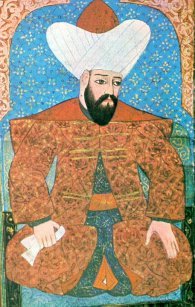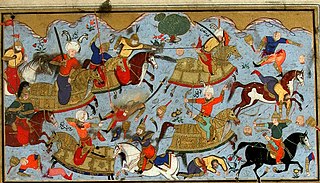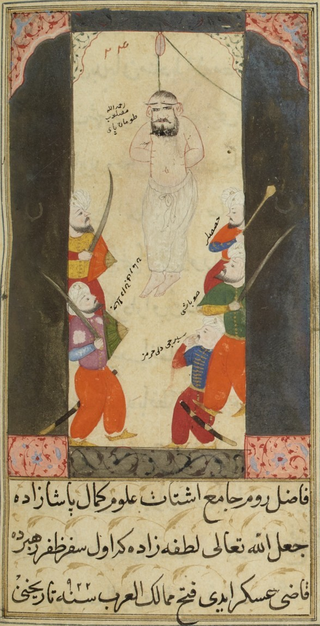
Mehmed II, commonly known as Mehmed the Conqueror, was an Ottoman sultan who ruled from August 1444 to September 1446, and then later from February 1451 to May 1481.

Orhan Ghazi was the second bey of the Ottoman Beylik from 1323/4 to 1362. He was born in Söğüt, as the son of Osman I.

Ertuğrul or Ertuğrul Gazi was a 13th-century bey, who was the father of Osman I. Little is known about Ertuğrul's life. According to Ottoman tradition, he was the son of Suleyman Shah, the leader of the Kayı tribe of the Oghuz Turks. These Turkomans fled from western Central Asia to Anatolia to escape the Mongol conquests, but he may instead have been the son of Gündüz Alp. According to this legend, after the death of his father, Ertuğrul and his followers entered the service of the Sultanate of Rum, for which he was rewarded with dominion over the town of Söğüt on the frontier with the Byzantine Empire. This set off the chain of events that would ultimately lead to the founding of the Ottoman Empire.
Halil İnalcık was a Turkish historian. His highly influential research centered on social and economic approaches to the Ottoman Empire. His academic career started at Ankara University, where he completed his PhD and worked between 1940 and 1972. Between 1972 and 1986 he taught Ottoman history at the University of Chicago. From 1994 on he taught at Bilkent University, where he founded the history department. He was a founding member of Eurasian Academy.
The Ottoman–Persian Wars or Ottoman–Iranian Wars were a series of wars between Ottoman Empire and the Safavid, Afsharid, Zand, and Qajar dynasties of Iran (Persia) through the 16th–19th centuries. The Ottomans consolidated their control of what is today Turkey in the 15th century, and gradually came into conflict with the emerging neighboring Iranian state, led by Ismail I of the Safavid dynasty. The two states were arch rivals, and were also divided by religious grounds, the Ottomans being staunchly Sunni and the Safavids being Shia. A series of military conflicts ensued for centuries during which the two empires competed for control over eastern Anatolia, the Caucasus, and Iraq.
The timeline of the Seljuk Sultanate of Rum (1077–1307) is summarized below.
The Battle of Torches was fought in 1583 during the Ottoman–Safavid War (1578–1590). The name of the battle refers to torches used during night clashes. The battle resulted in an Ottoman victory, and had thereby secured Dagestan and Shirvan until the end of the war.

The Battle of Çıldır was fought in 1578 during the Ottoman–Safavid War (1578–1590).
Hadım Sinan Pasha was Bosnian-Ottoman nobleman, politician and statesman. He served as the Grand Vizier of the Ottoman Empire from 1516 to 1517. He was a eunuch.
Özdemiroğlu Osman Pasha was an Ottoman statesman and military commander who also held the office of grand vizier for one year.

Musa Çelebi was an Ottoman prince and a co-ruler of the empire for three years during the Ottoman Interregnum.

Çınar incident is the name of a 17th-century rebellion in the Ottoman Empire. It is also sometimes known as "The Event of the Vakvak", named after a mythical tree on which human beings grew, as an analogy to the corpses hung from trees in the aftermath of the rebellion.

The recapture of Baghdad was the second conquest of the city by the Ottoman Empire as a part of the Ottoman–Safavid War of 1623–1639.

The capture of Cairo was the capture of the capital of the Mamluk Sultanate in Egypt by the Ottoman Empire in 1517.

Mustafa Çelebi, also called Mustafa the Impostor, was an Ottoman prince who struggled to gain the throne of the Ottoman Empire in the early 15th century. He was the Sultan of Rumelia twice during January 1419 – 1420 and January 1421 – May 1422.
Küçük Mustafa was an Ottoman prince who fought to gain control of the throne of the Ottoman Empire in 1422. It was used by the Ottoman chroniclers to distinguish him from his uncle Mustafa Çelebi, who also fought for the throne.
Ali of Karaman was the bey of Karamanids in what is now modern Turkey in the 15th century.
The Battle of Turnadağ was an engagement between the forces of the Ottoman Empire and the Beylik of Dulkadir of Turkey in 1515.










